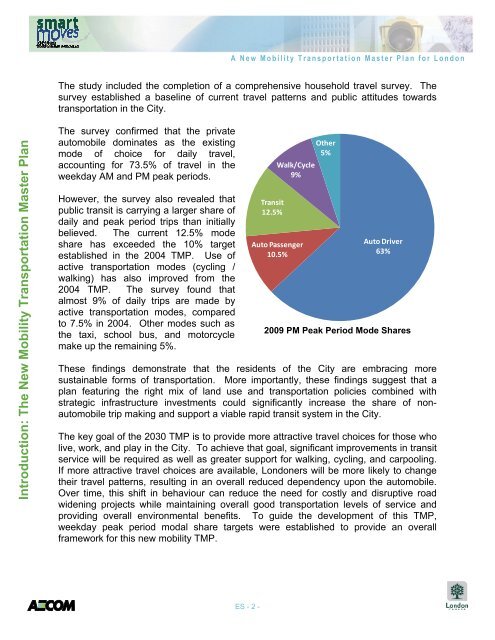A New Mobility Transportation Master Plan for London
A New Mobility Transportation Master Plan for London
A New Mobility Transportation Master Plan for London
You also want an ePaper? Increase the reach of your titles
YUMPU automatically turns print PDFs into web optimized ePapers that Google loves.
Introduction: The <strong>New</strong> <strong>Mobility</strong> <strong>Transportation</strong> <strong>Master</strong> <strong>Plan</strong><br />
A <strong>New</strong> <strong>Mobility</strong> <strong>Transportation</strong> <strong>Master</strong> <strong>Plan</strong> <strong>for</strong> <strong>London</strong><br />
The study included the completion of a comprehensive household travel survey. The<br />
survey established a baseline of current travel patterns and public attitudes towards<br />
transportation in the City.<br />
The survey confirmed that the private<br />
automobile dominates as the existing<br />
mode of choice <strong>for</strong> daily travel,<br />
accounting <strong>for</strong> 73.5% of travel in the<br />
weekday AM and PM peak periods.<br />
However, the survey also revealed that<br />
public transit is carrying a larger share of<br />
daily and peak period trips than initially<br />
believed. The current 12.5% mode<br />
share has exceeded the 10% target<br />
established in the 2004 TMP. Use of<br />
active transportation modes (cycling /<br />
walking) has also improved from the<br />
2004 TMP. The survey found that<br />
almost 9% of daily trips are made by<br />
active transportation modes, compared<br />
to 7.5% in 2004. Other modes such as<br />
the taxi, school bus, and motorcycle<br />
make up the remaining 5%.<br />
These findings demonstrate that the residents of the City are embracing more<br />
sustainable <strong>for</strong>ms of transportation. More importantly, these findings suggest that a<br />
plan featuring the right mix of land use and transportation policies combined with<br />
strategic infrastructure investments could significantly increase the share of nonautomobile<br />
trip making and support a viable rapid transit system in the City.<br />
The key goal of the 2030 TMP is to provide more attractive travel choices <strong>for</strong> those who<br />
live, work, and play in the City. To achieve that goal, significant improvements in transit<br />
service will be required as well as greater support <strong>for</strong> walking, cycling, and carpooling.<br />
If more attractive travel choices are available, <strong>London</strong>ers will be more likely to change<br />
their travel patterns, resulting in an overall reduced dependency upon the automobile.<br />
Over time, this shift in behaviour can reduce the need <strong>for</strong> costly and disruptive road<br />
widening projects while maintaining overall good transportation levels of service and<br />
providing overall environmental benefits. To guide the development of this TMP,<br />
weekday peak period modal share targets were established to provide an overall<br />
framework <strong>for</strong> this new mobility TMP.<br />
ES - 2 -<br />
Transit<br />
12.5%<br />
Walk/Cycle<br />
9%<br />
Auto Passenger<br />
10.5%<br />
Other<br />
5%<br />
Auto Driver<br />
63%<br />
2009 PM Peak Period Mode Shares


